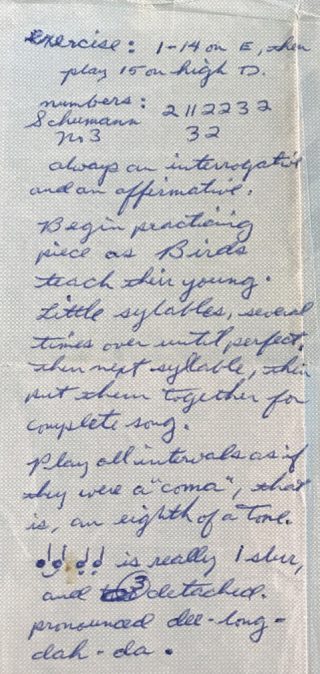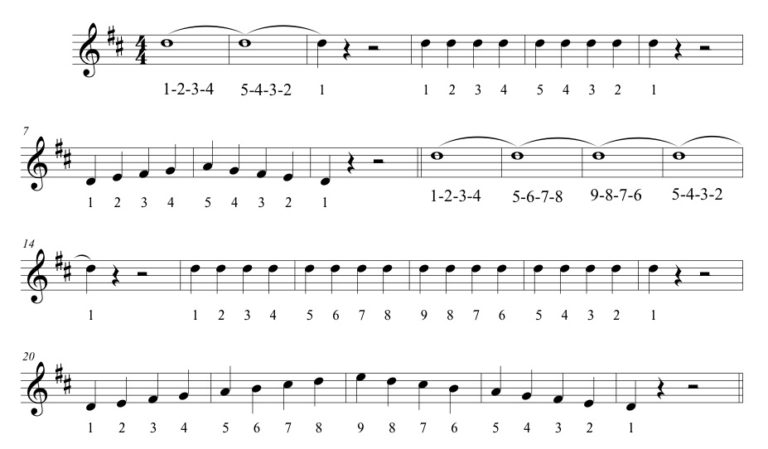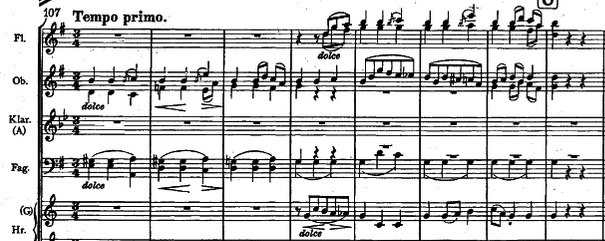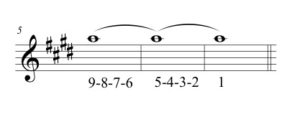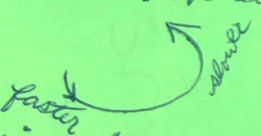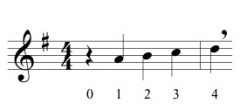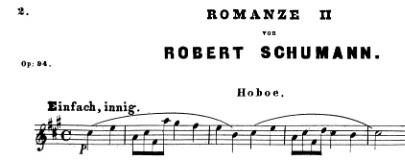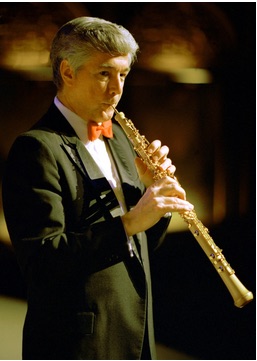In the summer of 1963, Donald Baker traveled to Nice with his Oberlin college friend, David Dutton, to study with Marcel Tabuteau and to assimilate his ideas about phrasing. Just one year later at the age of 21, Don won the position of Principal Oboe of the Dallas Symphony Orchestra performing there for nine years. In 1973, he became Principal Oboe of the Detroit Symphony Orchestra where he performed for over 40 years. Don performed as soloist with the Orchestra more than thirty times during his tenure.
Below is a transcription of Don’s handwritten notes taken in Nice during the summer of 1963 when he and David Dutton were studying with Marcel Tabuteau.
Donald Baker Notes
Taken during David Dutton’s Oboe Lessons in Nice
with Marcel Tabuteau
During the Summer of 1963
Preface by Charles-David Lehrer
Donald Baker and David Dutton always took their lessons with Tabuteau together. Each took notes while the other was playing. Here we present the notes taken by Don Baker when David Dutton was having his lessons with Tabuteau. Don jotted his notes down on whatever paper he had at hand. He numbered his first two lessons; the numbers of the remaining lessons were discerned from Don’s writing style, the paper type, and his choice of pencil or ball-point pen. It is here in Don’s notes that we have the first mention of why Tabuteau used two gouging machines: One machine was used to control the depth at the center of the cane; the other controlled the thickness at the sides of the cane. For the most part, it is Tabuteau who is speaking within Don’s notes. When Don makes an observation, it is clearly noted. Words within parentheses are his; those within brackets are the editor’s. There are three types of illustrations: 1) scans of Don’s original drawings; 2) scans of scores; and 3) Finale realizations.
Thousand Oaks CA, September 2017
An Example of Don Baker’s Notes
Realization of Donald Baker’s Notes by Charles-David Lehrer
1st Lesson
Control is like the numbers on a micrometer — never jumping from one to another more than one apart, but going through all the numbers to reach the desired one.
Never just blow, instead play!
Every note has a color change within a line of color changes.
Sing a good, healthy, open ahh, then play. Never play when completely full of air.
[An observation by Don] Tabuteau uses hand vibrato in the extreme high register of the oboe and also when playing softly.
Picture a snail shell, the way it starts from nothing in the center and then spirals larger, smoothly and continuously.
Every note has its definite place in the line. But we don’t worry about notes and don’t just play notes; instead, we play between them. That is the most important part of phrasing.
Picture, if you will, a music relief. We don’t produce it from the front, but from the back. One doesn’t chisel off the front, but pushes out from the back. Often to obtain the beautiful results we see on the surface, we have to do the reverse of what we think.
Picture a glass blower molding his glass. He blows out, and as the glass gets colder there is more resistance. He may blow a little more on one side than on the other to produce something different and rare. We should try to mold our phrases like a glass-blower molds his work.
Embouchure:
- Taught all around.
- Indentation of the jaw: tight there.
- Lips relaxed and flexible [Don observes:] A little flatter than I would have thought.
Reeds:
- Shaper width — resulting in 10.5 mm at the tip of the reed, no wider. [This maximum is considerably wider than the tip of today’s oboe reeds!]
- Cane soaked a half hour in hot water.
- Thickness of the cane: Sides 40 or 45mm; center 55 mm. It is impossible to obtain a gouge of these thicknesses with one machine; instead, use one machine for the center of the cane and another for the sides.
Exercises:
Phrasing assignment: Notate the up and down bows in these two excerpts:
Beethoven: Symphony No. 7, 1st movement.
Berlioz: Symphonie Fantastique, Marche au Supplice.

Feel the pressure of the air behind your nose, release the air through your nose if necessary.
2nd Lesson
Attacks: Always think and then play, never just blow. Sing “exhale” for 5 beats, then say “rea-dy,” then play.
Start at level 1 in your scale exercises and don’t go above it. Hold the final note as long as possible.
Don’t pinch the reed, and don’t force the air.
Never puff out your cheeks; keep them tight always.
The tongue should make a nice, clean taa.
Concentrate on the scale of colors. It is possible to execute 25 or 30 different tone colors on each note of the oboe.
There is no such thing in real music as volume; instead, just a scale of colors.
Never force the speed of the air.
Notes are to be played on the air-stream.
Notes should all fit into the scale of colors.
Diminuendos should always be on an Up inflection, because when you end on level 1 it is always Down. Like a good cigar, the smoke rises, but from a rotten cigar the smoke goes to the floor.
Play scale exercises using 2 slurred, 2 tongued. Note that the second note is the one that is slurred. Play all the way through it to the next tongued note.
Scale exercises: At first go up 5 levels and back. Then continue up a Perfect 5th to reach level 9, after which you must breathe (i.e. exhale); then proceed back down the scale to level 1.
Play with the idea of a great artist listening and beating time for you at all times, no matter when you pick up the horn.
Brahms: Symphony No. 2, 3rd movement.
Lift the four notes on the end of the above excerpt, scaling them as follows: 4-4-3-2.
Practice as if there are two oboes present. Practice with someone else, if possible:
There should be no stupid excess bodily movements.
Keep all fingers above the keys in playing position.
Perform the double loop in-between large intervals.
Just because a note is the highest one in a phrase, does not mean that it is the loudest.
Think continuously! Always be conscious of everything you are doing when you pick up an instrument to play.
In re-solve [V7-I]: re is Up; solve is Down.
Don’t play a musical line in a straight curve; instead, play like a gymnast chinning himself on the bar, with a loop at the top.
3rd Lesson
Exhale on the note, or it will sound like the blade of a guillotine has chopped it short.
Don’t just play. Exhale, inhale, then you can play.
Keep the reed covered by holding the oboe lower and back against your lower lip.
When slurring from low to high, you get the high note from the level of the preceding low note. Drive the low note to the desired level of the high note.
Fingers are stupid!
D = down; U = up:
Perform the above exercise in every key.
4th Lesson
You can’t make a Down without going Up, and vice versa.
The tone must start from dark, and then can be allowed to get brighter from there.
[Don’s observation] Tabuteau’s reeds have what looks like everything has been taken out of the middle in the back. They have a rather short heart, a long tip straight across, with no big bump at integration. They are very responsive but without too much vibration. The gouge is 40mm at the sides to a little under 55 at the center.
The gouging machine blade must be perfectly even.
[Don’s observations]
- The blade in one of Tabuteau’s gouging machines was small, so it did not gouge all the way to the edges of the cane.
- Tabuteau gouges his cane almost every day, soaking it for about 15 seconds after each process [splitting, guillotining, pre-gouging] leading up to actually gouging.
Feel the pressure behind the nose; this helps in keeping one’s throat open.
A big tone comes from a small one.
5th Lesson
In music there are many little syllabic groups, seldom more than two or three notes in each. Analyze every phrase carefully.
Never push down; always sustain or bounce the tone from underneath.
An Exercise:
- 1 to 13 tongued,
- breathe,
- 12 sustained to 10,
- touch 9,
- sustain to 5,
- to 1,
- hold 1.
- 1, 5, 9, 13 are finishing notes.
There are non-symmetrical phrases.
Phrasing example: ball and rebound.
Learning to play correctly is like taking dope [narcotics]. If you take it consistently, eventually you cannot help but get into the habit of doing it all the time.
Making an attack is like starting a train. Lots of resistance and weight on the rails. As the speed of the train increases, the weight on the rails [the embouchure] becomes less.
Put a clamp on your arm.
Project! Always play to the poor guy way in the back of the house who can’t afford to buy the front seat, but who knows more about music than anyone else there.
6th Lesson
Air speed, not volume.
Music: Think of the numbers continuously.
Perform like a boxer: He doesn’t stop in the middle of a swing: Resolve!
When you breathe, you do not stop in-between each breath, [but rather think as if you are continuing].
When you do a wrong thing…well, it’s a tragedy.
[You must] Think well before playing well.
Playing the oboe/playing music is like well-played golf: Placing the ball exactly where you want it makes all the difference.
Embouchure: Maintain it very tightly on level 1, but use less-and-less embouchure pressure on each higher level.
Exercises for long tones:
13 up, 13 down, played sustained and detached.

7th Lesson
Exercise: 1-14 on E, then play 15 on high D:
Robert Schumann: Drei Romanzen, No. 3.
- Note that in this movement, an interrogative is always followed by an affirmative.
- Begin practicing this piece as birds teach their young.
- Play the little syllables several times over until they are perfect. Then put them together for the complete movement.
- Play all intervals as if they were a comma, that is, an eighth of a tone. [Don explained that Tabuteau wanted a very smooth line without reaching across intervals–a minimum of adjustment.]
8th Lesson
The resistance of the reed is what we play against.
Drive: Play the space.
The artist plays the space between the chair and the stand; the amateur plays the chair or the stand.
Scale everything, especially the space between the notes:
Level 1= little bow.
Level 9 = full bow.
Always play like a violinist, using Up and Down bows and spacing.
Never breathe between an Up and a Down!
Breathe after a Down!
If you scale the length of notes, then you will scale the space. Use more space between smaller numbers than full-bowed large numbers. Always touch level 1 on which you begin and on which you end.
Reverse scale pattern articulation: two tongued, two slurred.
[Don comments]: Tabuteau’s volume level of playing in the orchestra seems very soft — better. I was impressed with the fact that I didn’t need to play loud to project in the orchestra.
9th Lesson: July 27, 1963 (this is the only specific date indicated)
A short note always goes to a long one. Never take a breath between short and long notes. A short note usually resolves to a long one.
Practice exercises in all articulations. Never forget to exhale before playing. Avoid an explosion in the reed from playing with too much air.
Always drive intervals. Play everything as if it is on one line, then the notes will be easy to execute.
Roller coaster:
Reeds come from making them to express what you want. They are made for your musical ideas.
Go Up when making a diminuendo: This is like keeping a balloon in the air, bouncing it lightly from beneath.
Play everything on level 1 at first with inflections and punctuation, but no dynamics. Note that a big tone comes from a little one.
Reverse all patterns. If patterns cannot be reversed, then they are no good.
Be careful not to diminish when driving one note to another; they must be on the same line.
Never blow into the reed! Blow against your nose; feel the pressure in back of your nose; the reed will work by itself. The pressure of the wind gives inflection.
10th Lesson
- Exhale for 5 to 10 seconds before playing, until you become conscious of it. Don’t blow into the reed; play only with your air pressure.
- How to take a breath: Always exhale on the note preceding the taking of the breath.
- When to take a breath: Except on rare occasions, it is safe to take a breath after the first beat of a measure. An exercise:
- It takes two notes to make an interval. Also it takes two strikes to make a rhythm.
[Don comments] This was given by Tabuteau to explain the importance and significance of level 0.
- Practice the following concepts on a line comprised of the same note: pressure, wind, inflection, punctuation, and grouping. Then add the melodic pattern:



